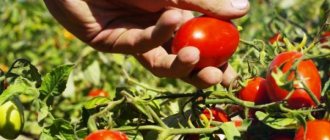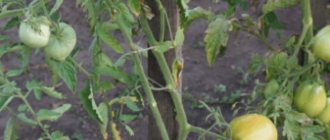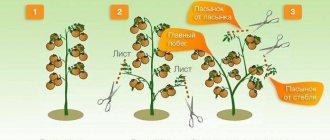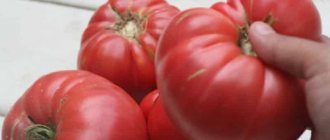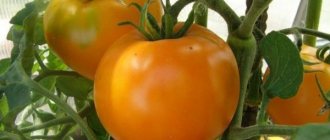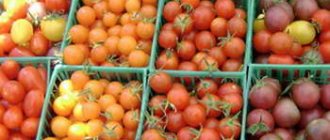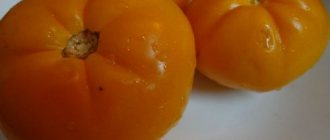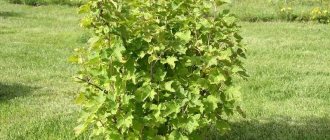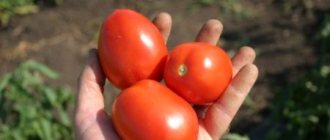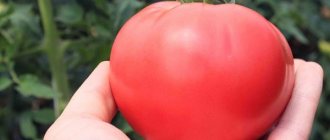The Ob Domes tomato was named for the unusual shape of the fruit. Tomatoes of this variety are elongated, with a pointed nose, similar to domes. They are always popular among summer residents for their large fruits, good taste and low bushes that are easy to care for.
| Height | Landing location | Ripening time | Fruit color | Fruit size | Origin | Fruit shape |
| short | Open ground | Early ripening | Pink | Large | Hybrid | Plum-shaped or oval |
Description and characteristics of the variety
Large-fruited hybrid with a height of 50 cm. Bred by Siberian breeders. The author of the variety is agro. The latest achievements of domestic selection are collected in the Ob domes.
The hybrid is suitable for growing in open ground and under film. Tomatoes are ready for harvesting 90 days after germination.
The fruits are large, weight 200-260g. The color is bright, raspberry pink or bright red. The shape is oval-heart-shaped. Some tomatoes have a weakly defined nose. The fruits are fleshy, sweet, with thick skin, universally used, tasty in salads, suitable for making sauces and canning.
How to grow tomatoes
After 50–55 days, the seedlings are transplanted into open beds . If possible, the tomato bed is located in a sunny place, protected from the wind.
Reference! The best predecessors for tomatoes are carrots, greens, cabbage, and legumes. After them, the earth is filled with nutrients necessary for the growth and development of tomatoes.
Planting pattern: 50 cm – distance between plants; 40 cm – row spacing .
For 1 sq. m place up to 6 bushes , since the plants are compact and low-growing.
A week after transplantation, the tomatoes are watered and fed with organic or mineral fertilizers . An infusion of mullein is suitable as an organic substance; it is used in a dilution of 1:15 so as not to burn the root system.
Tomato loves abundant watering, once every 7-10 days..
After watering, the soil is loosened, hilled up and weeds with roots are removed . Mulching helps keep the beds moist longer.
Reference! The variety is watered with warm, settled water heated in the sun.
The culture needs obligatory garter .
They are often tied to several stakes at once, since the branches are hung with fruits. To do this, when transplanting seedlings, several wooden stakes or metal rods are installed next to each bush. Sometimes they are tied to tensioned ropes. Stepchildren are removed only up to the first hand . The maximum fruiting rate is observed when the plant forms several stems. In open ground the crop is grown in 4-5 stems, in a greenhouse it is formed in 3-4 stems.
Feed twice during the entire growing season . Organic or complex mineral fertilizer containing nitrogen, phosphorus and potassium is fed during mass flowering. During ripening, fertilizing is carried out, consisting of phosphorus and potassium fertilizers. This technique improves the taste of tomatoes, making them sweeter and more aromatic. While the fruit is pouring, stop watering and loosening the soil.
Reference! The Urals are considered the best region for growing tomatoes. Ob Domes.
Diseases and pests
Despite the resistance to various diseases embedded in the genes, the tomato sometimes turns out to be powerless against infections and pests . Sometimes, even with proper and timely care, summer residents complain about crops being damaged by one or another disease, blaming low-quality seeds, stupid sellers and, in general, the whole world, in which there are only Colorado potato beetles, mole crickets and various molds. But this is the law of Nature, natural selection, which forces pests to adapt even to the strongest organisms in order to survive themselves.
Powdery mildew affects crops in a greenhouse . The leaves become covered with a white coating, wither and fall off. The following drugs help to cope with it: “Quadris”, “Topaz” and sodium humate (1 g per 1 liter of water).
Anthracnose is a fungal disease . Leaves and fruits suffer. The foliage withers, falls, vegetables become covered with brown spots. Drugs will help in the fight against it: “Oxychom” or copper sulfate.
It must be said that
the main cause of fungal diseases is high humidity .
Therefore, it is important to prevent the beds from becoming waterlogged, much less moisture stagnating in them. It is more difficult in rainy summers when moisture control is impossible. A dangerous pest of tomatoes is the gnawing cutworm . This butterfly itself is not dangerous, but its caterpillars feed on plants and fruits. To prevent egg laying, the crop is treated with wormwood infusion with the addition of ash and liquid soap.
The Colorado potato beetle and slugs eat the leaves and actively reproduce . The larvae and insects themselves are collected by hand. To prevent slugs, tobacco is sprinkled around the plants. They are also good at the smell of beer, so they set up traps for slugs by pouring a little beer into them.
Other varieties of tomatoes:
Ultra early tomato “White filling”
How to grow Pudovik tomato for greater yield
Features of cultivation and storage
The main feature of growing this variety is its absolute unpretentiousness. But tomatoes are responsive to watering and fertilizing.
The tomato grows well even in northern regions with short summers if it is cultivated through seedlings. In areas with recurrent spring frosts, it is necessary to provide for the possibility of covering tomatoes planted in open ground with film.
Planted per square meter:
- in open ground - 5 bushes, forming several stems (up to 5);
- in a greenhouse - 3-4 plants, forming two or three stems.
How to grow seedlings
Sowing of seeds is carried out 50-55 days before planting seedlings in the ground .
To accelerate germination, seeds are treated with a growth stimulant.
The soil mixture is prepared in advance from garden soil, washed river sand, ash and peat. Then the prepared mixture is laid out in containers.
You can plant both in a common wooden box and in individual containers : peat or seedling pots, plastic cups.
The seed is placed in grooves 1 cm deep . Level the soil on top, moisten it with a spray bottle and cover the containers with glass or film.
Before emergence, the optimal temperature is considered to be +23-25 degrees . Until germination, the seeds are kept in a dark room.
After the first shoots appear, the covering material is removed and the containers are moved to a lighted place, on the windowsill . If there is not enough light, fluorescent lamps are used as additional lighting.
Young bushes respond well to feeding . As soon as the first shoots appear, complex fertilizers are applied to the soil. As the surface layer of soil dries, the seedlings are watered with warm water.
When 2 true leaves appear, pick . If the seeds are sown in a common box, then the sprouts are planted in separate containers. Picking helps select stronger plants and promotes the development of the root system.
2 weeks before transplanting into open ground, the seedlings are hardened . The hardening procedure involves staying outside for several hours during the daytime. At the same time, the temperature is reduced to 13 degrees in the room where the seedlings are brought in overnight. The time spent outside gradually increases to 24 hours.
Open ground tomatoes in Siberia
Tomato variety for the northern regions of the “Dome of Siberia”
Residents of the northern regions also have their own varieties of tomatoes.
And they are no worse than the southern ones. They are usually frost-resistant and have good immunity. These are usually large-fruited species. Today we present to you an interesting and rather new hybrid - “Domes of Siberia”.
- History of selection
- Tomato “Domes of Siberia F1”: variety description
- Fruit characteristics
- Features of cultivation
- Diseases and pests
- Conclusion
- Video
History of selection
This hybrid species was bred in Russia by scientists from Siberia specifically for harsh conditions. Received state registration in 2012.
Since then, it has been popular among gardeners who live far from the warmest regions of Russia and grow tomatoes in greenhouses.
Tomato “Domes of Siberia F1”: variety description
This is a hybrid bred not so long ago. The plant is short, approximately 60-80 cm. According to the type of bush, it belongs to the standard, deterministic types. Recommended for growing in greenhouses and film shelters. It is resistant to harmful insects and most diseases.
From the moment of planting the seedlings to the first fruits, 90-95 days pass, that is, this is an early type of tomato.
This hybrid variety has a very high yield, this is one of its many positive properties. With proper care and planting scheme, 4-5 bushes per square meter. m you can collect up to 15-17 kg of excellent fruits.
Among the main features it is worth highlighting its resistance to temperature changes and especially to low temperatures. It is also worth noting the taste of tomatoes.
Fruit characteristics
- Ripe fruits are red and round in shape.
- They are quite small in weight compared to other representatives of Siberian varieties, only 200-250 grams.
- Number of cameras 4-5,
- dry matter content is about 5-6%.
- The fruits tolerate storage well and do not lose their marketable properties during long-term transportation.
The fruits of this species are very tasty fresh. They also make excellent juice, thanks to the optimal combination of sugars and acids. Smaller fruits are ideal for preparing homemade preparations for the winter.
Advantages and disadvantages: The main positive qualities of “Domes of Siberia” include:
- early harvest;
- resistance to low temperatures;
- low sensitivity to lack of lighting;
- high productivity;
- resistance to diseases.
Among the main disadvantages, it is noted that this variety is not suitable for cultivation in other regions.
Features of cultivation
These tomatoes do not tolerate heat very well, as they were created for conditions in Siberia. Therefore, growing them in the southern regions will be very problematic and will bring a lot of trouble, and the result will not please you.
The most suitable conditions for it will be the regions of Southern Siberia or the middle zone, but not the hot south.
Despite the fact that this is a low-growing bush, its branches need garter due to the fact that the fruits are still quite heavy.
This hybrid responds very well to complex fertilizers. At the growth stage, the branches are pruned, forming 2-3 stems with a garter and pinching up to the first cluster.
Diseases and pests
Since the plant is a greenhouse plant, pests and diseases are mostly those that are characteristic of greenhouses.
Among the most malicious pests, it is worth noting the greenhouse whitefly, which is combated with the help of the drug “Confidor”. This type of tomato can also be susceptible to cotton aphid infestation. You can get rid of it using the “Zubr” product.
Diseases may be subject to brown or dry spotting. To prevent this disease, you should not overwater the bushes and try to keep the temperature to 25-28 degrees. If the disease has affected your plantings, then you should use preparations containing copper.
Conclusion
If you follow very simple care rules, the “Dome of Siberia” tomato will not bring much trouble
It is resistant to diseases and weather changes, and this is very important, especially if a beginner gets down to business. Great harvests to everyone!
Video
You can learn about other varieties of Siberian selection from the video clip:
Popular varieties for the greenhouse
High-yielding tomato varieties are able to grow and develop well in greenhouse conditions. The most popular types that are intended for greenhouse conditions include:
- Pink elephant is a heat-loving crop; among productive varieties, this specimen is considered to be unpretentious. Its fruits when ripe acquire a pleasant pink color. The vegetable is suitable for gardeners who have little agricultural experience.
- Among the tomato varieties grown in greenhouses and producing a good harvest, one can highlight the hybrid tomato Obskie Domes. The vegetable is characterized by early ripeness and good adaptability. The fruits are large and fleshy, the bushes are low.
- Vologda's productive tomato is worthy of the attention of gardeners. This nightshade plant can be a boon for any greenhouse design. An early ripening and productive species, its fruits are suitable not only for fresh use, but also for making juices and sauces.
- Summer residents praise the Ural hero - the bushes are tall, reaching two or more meters. The crop requires attention, it is tied up in a timely manner, the soil is mulched, fertilized, etc. The returns from this species are always excellent.
We invite you to familiarize yourself with Metal gazebos for summer cottages
Yield varieties - Yellow Delicacy, Pink Honey, Evpator f1, Dachnik and many others - can become desirable for gardeners. Multiple-fruited tomatoes differ in appearance, ripening period, taste and fruiting period.
Among the early-ripening and weather-resistant tomatoes that are worth planting in a greenhouse, there are interesting specimens, for example, Igranda, Biff and Major f1. The bushes of the listed plants do not retract more than 2 m; their fruits have a rich tomato taste and beautiful appearance. The productivity of the bushes is high.

